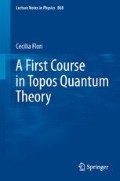Abstract
In this chapter we will define the topos notion of a one-parameter group taking values in the complex number object and in the real number objects. To this end we first of all need to upgrade the monoids \(\underline{\mathbb{C}}^{\leftrightarrow}\) and \(\underline{\mathbb {R}}^{\leftrightarrow}\) to groups. This can be done using a standard method called Grothendieck k-Construction already mentioned in Doring and Isham (2008). Having done that the construction of a one-parameter group can be defined. This in turn allows us to define the topos analogue of the Stone’s theorem which uniquely associates to each self adjoint operator \(\breve{\delta}(\hat{A}): {\underline{\varSigma}\rightarrow \underline{\mathbb{R}}}\) a one parameter group \(\underline{Q}^{\hat{A}}\). This is of particular importance in the view of defining a unique time evolution. In fact, given a Hamiltonian operator \(\underline{H}\), the topos analogue would be \(\breve{\delta}(\hat {H})\) with associated the unique one-parameter group of transformations \(\underline{Q}^{\hat{H}}\). This group would represent the group of time evolutions in topos quantum theory. The detailed analysis of such a group and how it acts had not yet been carried out but it would be of particular interest to do so.
Access this chapter
Tax calculation will be finalised at checkout
Purchases are for personal use only
Notes
- 1.
Here each α [μ,ν] represents an abstract automorphisms on \(\mathcal{H}\) parametrised by [μ,ν].
- 2.
Essentially the abelian property is inherited by the group \(K(\underline {\mathbb{R}}^{\geq})\).
- 3.
We could have defined the map
 (20.42)
(20.42) (20.43)
(20.43)but this would not have been 1:1.
- 4.
Similarly as for \(\underline {K}\) even here the elements α [μ,ν] should be understood as automorphisms on \(\mathcal{H}\) parameterised by [μ,ν].
- 5.
Here strongly continuous means that, for any \(\psi\in\mathcal{H}\) and t→t 0, then U t (ψ)→U(t 0)(ψ).
- 6.
We will now introduce the following notations (i) \(\hat {A}_{\smile}\hat{B}\) indicates that \(\hat{A}\) and \(\hat{B}\) commute; (ii) \(\hat{A}_{\smile\smile}\hat{B}\) means that \(\hat{A}\) commutes with \(\hat{B}\) and any other operator which commutes with \(\hat{B}\).
- 7.
Recall that \(\mathcal{V}_{f}(\mathcal{H})\) is the poset \(\mathcal{V}(\mathcal{H})\) but were the group is not allowed to act.
- 8.
Recall that, given a context V, the fixed point group K FV is defined as \(K_{FV}:=\{g\in K|\forall \hat{A}\in V g\hat{A}g^{-1}=\hat{A}\}\).
- 9.
Recall that the spectral family is uniquely specified by the operator it decomposes.
References
A. Doring, C. Isham, ‘What is a thing?’: topos theory in the foundations of physics. arXiv:0803.0417 [quant-ph]
C. Flori, Group action in topos quantum physics. arXiv:1110.1650 [quant-ph]
Author information
Authors and Affiliations
Rights and permissions
Copyright information
© 2013 Springer-Verlag Berlin Heidelberg
About this chapter
Cite this chapter
Flori, C. (2013). One-Parameter Group of Transformations and Stone’s Theorem. In: A First Course in Topos Quantum Theory. Lecture Notes in Physics, vol 868. Springer, Berlin, Heidelberg. https://doi.org/10.1007/978-3-642-35713-8_20
Download citation
DOI: https://doi.org/10.1007/978-3-642-35713-8_20
Publisher Name: Springer, Berlin, Heidelberg
Print ISBN: 978-3-642-35712-1
Online ISBN: 978-3-642-35713-8
eBook Packages: Physics and AstronomyPhysics and Astronomy (R0)



